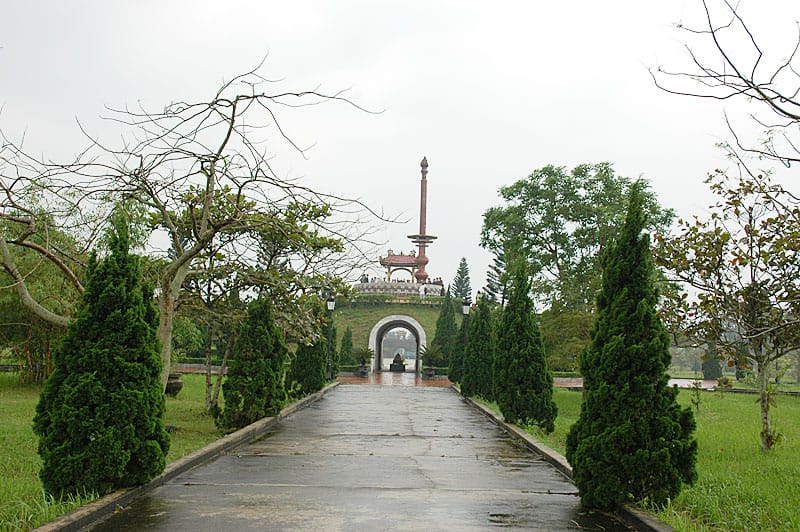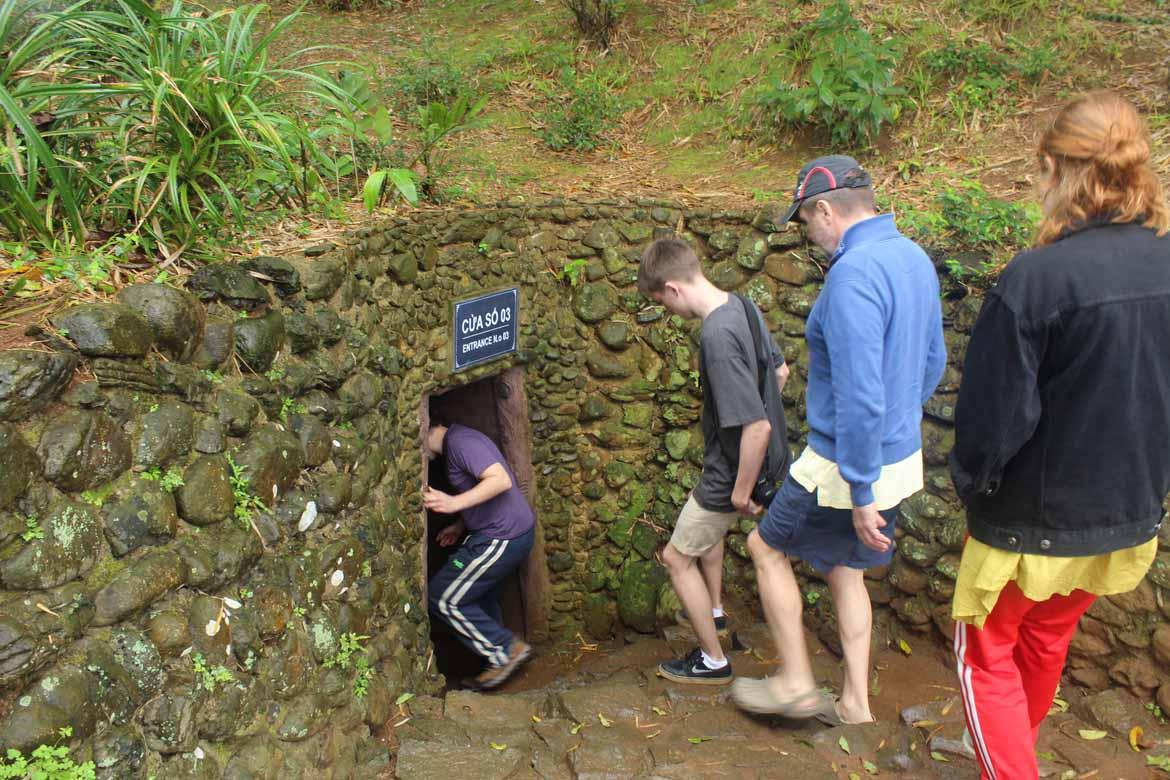Coming to Quang Tri Province, tourists are able to take an interesting holiday in the Demilitarized Zone (DMZ).
Quang Tri, which was the province capital of that area, is located in the Central Region of Vietnam, near the crossways between North and South Vietnam, Laos, and Thailand. The province preserves many remains from the anti-American resistance war such as the ancient citadel of Quang Tri, Khe Sanh Combat Base, Truong Son National Cemetery, Truong Son trail, Vinh Moc Tunnels, Hien Luong Bridge and Ben Hai River.
In 1954, Ho Chi Minh’s government in the north and the French colonial administration in the south agreed on an armistice that involved a ‘temporary’ partition of Vietnam. The Ben Hai River, in the extreme north of Quang Tri province, became the arbitrary line dividing the two halves of the country. When the southern ‘government’, backed by the US, reneged on the national elections promised in the agreement, Quang Tri became the theatre where most of the important scenes of the Vietnam War were staged. From then, until the early seventies when the Vietnamese army overwhelmed the defenses along the southern edge of the DMZ, Quang Tri was a battlefield, one of the most intensively bombed areas in military history. It left a barren desert created by hundreds of thousands of tons of high explosives, estimated to be the equivalent of seven Hiroshima atom bombs, as well as napalm, phosphorous and herbicide.
When you arrived in Quang Tri, you can take about an hour to the south of Ben Hai River, which was home to the DMZ during the war. In military terms, a DMZ is an area, usually the frontier or boundary between two or more military powers (or alliances), where military activity is not permitted, usually by a peace treaty, armistice or other bilateral or multilateral agreement.
Plan of tunnel areas in DMZ
5 km either side of the river was declared a DMZ – a stark contrast to what really took place in this region. In fact, the surrounding region experienced some of the heaviest fighting during the Vietnam War. Some areas, such as Vinh Moc were termed Free Fire Zones, allowing a virtual free for all without fear of future repercussions and everything was designated a target. As a result of this heavy fighting, there is still heaps live ordnance lying around. There have been some casualties as unexploded bombs blow up when farmers are working on their lands nearby or children run-up in a play. Khe Sanh, in particular, was immortalized during and after the conflict.
Nowadays, when you catch the train or bus from anywhere South of Dong Hoi to the DMZ, bomb damage and craters are still evident in paddies, beside the railway tracks and beside the roads and bridges. As you get closer to Dong Ha you will notice huge eucalyptus groves, themselves a legacy of the war. These areas were completely devastated either by relentless shelling or defoliation during the war and were eventually replanted with eucalyptus trees, chosen for their durability and speedy maturity. Moreover, Dong Ha, which is the present provincial capital, has flourished. It has a large deep-water port, a direct route to Laos via the Lao Bao border gate 80kn to the west, and is likely to be an important hub on the planned Trans-Asia highway. It has a decent hotel and is a good centre from which to explore the DMZ in depth.
Following Khe Sanh Combat Base, you can take across the river into the north and visit the Vinh Moc tunnels, which was an elaborate tunnel system created by the North Vietnamese. Walking down into them was quite amazing, the dirt is still moist to the touch, and perfectly formed. They even had meeting rooms and a place for the women to give birth. Needless to say, you will surely have to duck for the entire walk-through. When visiting North Vietnamese Army soldiers at the tunnels, it is really sobering. Yet, Vietnamese people are much more focused on the future rather than the past, so there was no animosity at all.
Quang Tri Citadel
Quang Tri Citadel is situated in the central of Quang Tri Town. Quang Tri Citadel was a military bastion and it was also an administrative head office of Nguyen Dynasty in Quang Tri Province (1809 -1945). Quang Tri Citadel was built in 1824, during the 4th year of the reign of Minh Mang. The citadel is approximately 60km north of Hue.

The citadel had a style of Vauban architecture with its circuit of 2,160 m – one door each side. There were four fortresses jutting out from each four corners to control the four citadel gates. Inside was the town palace surrounded by a system of thick walls with a circuit of 400m. The town palace was a three-roomed house whose two wings were used as places for the King to worship, and to give promotions to his inferiors or to occasionally celebrate festivals. Outside the town palace, there were a flagpole and castles such as Tuan Vu, An Sat and Lanh Binh and a rice store, etc and under the French domination, soldier camp and tax agency were added. However, there are no remains of the past there nowadays – due to the destruction of U.S bombs in the hot summer of 1972.
The citadel has gone down in history as a glorious period of the nation’s war against foreign invasion. The Vietnamese people are proud of it, and foreigners admire it.
Looking at its walls riddled with bullet holes, visitors will feel how devastating the war was. In order to commemorate the soldiers’ meritorious service, a monument was set up in the centre of the citadel as a symbol of the indomitable spirit of the Quang Tri people and army and as a token of gratitude to the sacrifices of the fallen soldiers for the independence and freedom of the nation.
Vinh Moc Tunnels
Vinh Moc Tunnels is situated in Vinh Linh Village, Vinh Thach Commune, Vinh Linh District, Quang Tri Province. Vinh Moc Tunnels – a place well-known as an underground village constructed to avoid bombardments during the American War (1965-1966).

Displays inside the tunnels system of Vinh Moc in DMZ Quang Tri
Situated 13km east of the National Highway 1A and just 6km away from the sea, Vinh Moc Tunnels has become a favourite destination for foreign tourists, especially American war veterans.
The spectacular tunnel network stands as a testament to the endurance, wisdom, and bravery of the local people in their fight for independence. The tunnels used to be thousands of meters long. But now there remain only 1,700m. This underground network is linked with 13 doors (seven opening to the sea and six to the hills). The structure is divided into three layers, the deepest being 23m underground. They are connected by a 768m main axis that is 1.6 to 1.8m high and 1.2 to 1.5m wide. It is linked to the sea by seven exits, which also function as ventilators and to a nearby hill by another six.
Along the two sides of the main axis are housing chambers. There is also a large meeting hall with a seating capacity of 50 to 80 people, which was used for meetings, movies, art performances, surgeries, and even the delivery of babies (17 were born here). There are also four air wells, two watch stations, and three water wells. The village featured unique Hoang Cam stoves, named after the general who invented the store to allow for underground cooking without emitting smoke, thus evading the discovery by bombers.
Before entering the tunnels, visitors are shown the displays of that brutal period in Vietnam’s history by some photos. They provide a sharp contrast for the vitality of the local people during wartime, celebrating on the victory day.
In 1976, the Ministry of Culture and Information recognized Vinh Moc Tunnels as a national heritage site and included it in a list of especially important historical sites. To ensure security for visitors, the tunnels were restored with reinforced concrete and internal lightening.
Tour information to DMZ in Quang Tri
There are some special-theme tours available for those who want to tour around the DMZ area in Quang Tri and understand more about the Vietnam war. Those who are interested in this type of itineraries can check out some tour programs that started from Hue city to Quang Tri and DMZ area. Most of the DMZ tours will depart from Hue city.






